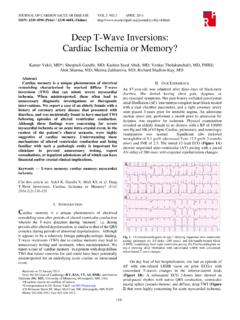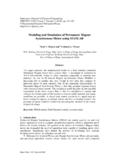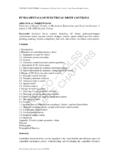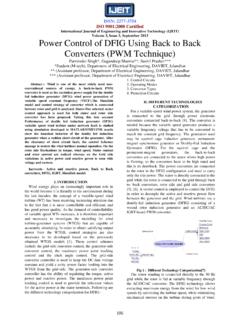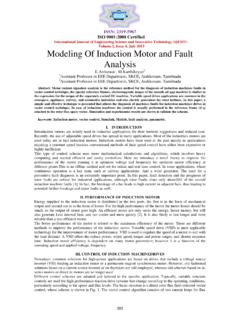Transcription of Design and Performance of Solar Tracking Photo …
1 INTERNATIONAL JOURNAL OF CONTROL, AUTOMATION AND SYSTEMS APRIL 2013 ISSN 2165-8277 (Print) ISSN 2165-8285 (Online) 49 Abstract In the present paper, mathematical analysis, control system, and simulink model have been developed, designed and tested using the MATLAB/Simulink for Tracking a Solar energy Photo /voltaic module in order to achieve its optimal operational efficiency. The input data provided to the designed control system, in form of the altitude angle, is obtained from the solution of a system of governing equations which describe the movement of the sun from the sunrise to the sunset. The optimum Performance of the designed Tracking system can be achieved if the angle of incidence is equal to zero during the sunshine. In such case, the Solar energy acquired by the system is maximized. The obtained results show the simplicity, accuracy and applicability of the present designed controller to meet all operational requirements.
2 Moreover, the proposed Tracking system can be used either for educational or research purposes. Index Terms Design , MATLAB/Simulink, Performance , Photo -voltaic System, Solar Energy, Sun Tracker. I. INTRODUCTION HOTOVOLTAIC Solar system is considered to be as a renewable energy solution for most of energy crises and environmental pollutions. In order to increase the Solar system efficiency, it is required to maximize the output power by keeping the Solar panels aligned with sun. Consequently, a Tracking of the sun position with high degree of accuracy is required. The main purpose of a Solar Tracking system is to track the movement of the sun during the aunshine in order to orientate the Solar panel to the maximum radiation in all time. Large numbers of Tracking systems have been developed and introduced previously in the literature. More details can be found in the high level overview of the sun Tracking systems presented by [1].
3 In such presented review, it has been shown that the sun Tracking algorithm can be classified into closed-loop and open-loop systems, according to its control mode. Each system acquires relative advantages/disadvantages which strongly affect their Performance . ---------------------------------------- ------------------------------ 1 Mechanical Engineering Dept., Faculty of Engineering, Taif University, 888, Taif, Saudi Arabia. (e-mail: 2 Mechanical Engineering Dept., Faculty of Engineering, Menoufiya University, Shebin El-Kom, Menoufiya, Egypt. 3 Department of Automatic and Mechatronics Systems, Vladimir State University, Vladimir, RF. 4 Alpha Center for Engineering Studies and Technology Researches, Amman, Jordan. Recently, a simple model for Tracking the apparent movement of the Sun for arbitrary latitudes has been developed [2]. Although this model can be used in various applications, however, such model has certain limitations concerning the applied set of equations, which is based on 'integer days' instead of depending on the more accurate continuous time data.)
4 More recently, a mathematical simulation has been proposed and evaluated for a Solar Tracking of two degree of freedoms controlled by fuzzy logic in order to achieve the correct positioning of a photovoltaic Solar cell and get as much sunlight during the sunshine [3]. Such proposed system is an economical alternative only in the medium power generation to meet electricity demand in small areas. In the present paper, a simplified analysis is made to obtain the altitude angle, which in turn is provided to a well designed control system that orientates the Solar panel movement. A MATLAB/simulink model is developed to obtain the output of the control system. The proposed system can be used in Solar energy research and as an educational system as well. II. METHODOLOGY The present model is applied for Taif city located at the western of Saudi Arabia, as shown in Fig.
5 1. The history of temperature in such city for 7 days is shown in Fig. 2. Fig. 1. Taif location in the map of Saudi Arabia Fig. 2. History of temperature in Taif city Design and Performance of Solar Tracking Photo -Voltaic System; Research and Education Ashraf Balabel1,2*, Ahmad A. Mahfouz3,4, Farhan A. Salem1,4 P INTERNATIONAL JOURNAL OF CONTROL, AUTOMATION AND SYSTEMS APRIL 2013 ISSN 2165-8277 (Print) ISSN 2165-8285 (Online) 50 The governing set of equations, applied in the present paper, is the modified one explained previously in [4]. It is required here to calculate: 1. The altitude angle ( ) for the angle between the Solar radiation and the Solar panel surface. 2. The day length (Ts) in a specified day during the whole year in Taif area. It is assumed that the latitude and longitude angles for Taif city are about and , respectively. The Solar panel surface is assumed to be located horizontally.
6 The calculated altitude angle is considered as the input data for the designed control system, which in turn adjust the Solar panel; in such manner that the Solar radiations remain perpendicular on the Solar panel surface. The altitude angle can be evaluated from the following equation: =sin-1(sin L sin + cos L cos cos h) (1) where L, , h are the latitude, declination and hour angles, respectively. The declination angle can be evaluated as a function of the day number, n as: sin [(360/365)(284+n)] (2) The hour angle is defined as: h= (No. of min. from local Solar noon) (3) where the value of h is assumed positive in the afternoon period. The day length (or the sunshine time) (Ts), which is considered as the period from sunrise to sunset, can be calculated from the following equation, Ts = (C/15) cos-1 (tan L tan ) (4) The day length calculated from the above equation is divided into a number of minutes and, consequently, the altitude angle is easily defined for each minute in the day specified.
7 The constant C, in the above equation may be used as C=1 for calculation of sunrise and sunset given as hours before and after local noon, respectively. If C=2, the total daytime is calculated in hours. The above equation is known as a trigonometric formula to compute the time of sunrise and sunset, given as a function of the number of hours before and after the local noon., which defined as the time of day when the sun is directly overhead. The local Solar noon is simply calculated according to the longitude west and the known Julian cycle. A sample of data obtained for Taif City, and on 20th August, can be seen in the following table: TABLE I A sample of the calculated data for Taif City on 20th Aug. Day time Sunrise Sunset Local Solar noon 12 hours and 38 minutes 6 hours and 20 minutes 6 hours and 18 minutes 12 hours and 22 minutes Fig. 3. Change of Altitude angle with time for 21st August Fig.
8 3 shows the distribution of the altitude angle for Taif city on 20th August. The maximum altitude angle obtained is about at the local Solar moon. The time for sunrise and sunset is also defined. III. SYSTEM Design The Solar tracker system requires movement in different directions, and uses electric motors as prime mover, based on this; Solar tracker system motion control is simplified to an electric motor motion control. In Solar Tracking system Design , any light sensitive device can be used as input sensor unit to detect and track the sun position, based on sensors readings, and generated sun Tracking error, the control unit generates the voltage used to command the circuit to drive the motor, that outputs the rotational displacement of electric motor, which is the motion of Solar Tracking system. Simplified block diagram representation of Solar Tracking system is shown in Fig.
9 4. DriveDC motorGearsSolarp anelControllerPosition sensorErrorLight sensor1 Light sensor2 Power supplyComp aratorangle Fig. 4. Simplified block diagram representation of Solar Tracking system A. Light sensor selection and circuit Light detecting sensor that may used to built Solar tracker include; phototransistors, photodiodes, LDR and LLS05-A light sensors, a suitable, inexpensive, simple and easy to interface sensor is analog LDR. Depending on particular application and required maximum energy INTERNATIONAL JOURNAL OF CONTROL, AUTOMATION AND SYSTEMS APRIL 2013 ISSN 2165-8277 (Print) ISSN 2165-8285 (Online) 51 receiving of Solar panel, two main Solar Tracking system arrangements; one-axis (one directional) sun Tracking system using two light detectors and two-axis (two directional) sun Tracking system using four light sensitive sensors, in both cases, sensors are mounted on the Solar panel and placed in an enclosure, the LDRs are screened from each other by opaque surfaces.
10 For two axis system, can be modified to have the arrangement shown in Fig. 5 (d). For one-axis sun Tracking system, one light Tracking circuit consisting of two sensors, and one electric motor are used, meanwhile, for two-axis sun Tracking B. Actuator and drive selection Electric motors most used for Solar tracker are PMDC and stepper motors, the proper selection of motor and drive combination can save energy and improve Performance . A suitable, available, easy to control and interface selection is PMDC motor. For bidirectional driving, a motor can be driven via H-bridge drive formed by two pairs of Darlington transistors, or H-Bridge in IC s, L293D, which is 16 pin chip dual H-Bridge motor driver, so with one IC we can interface two DC motors. IV. BASIC SYSTEM MODELING The Permanent Magnet DC motor is an example of electromechanical systems with electrical and mechanical components.


